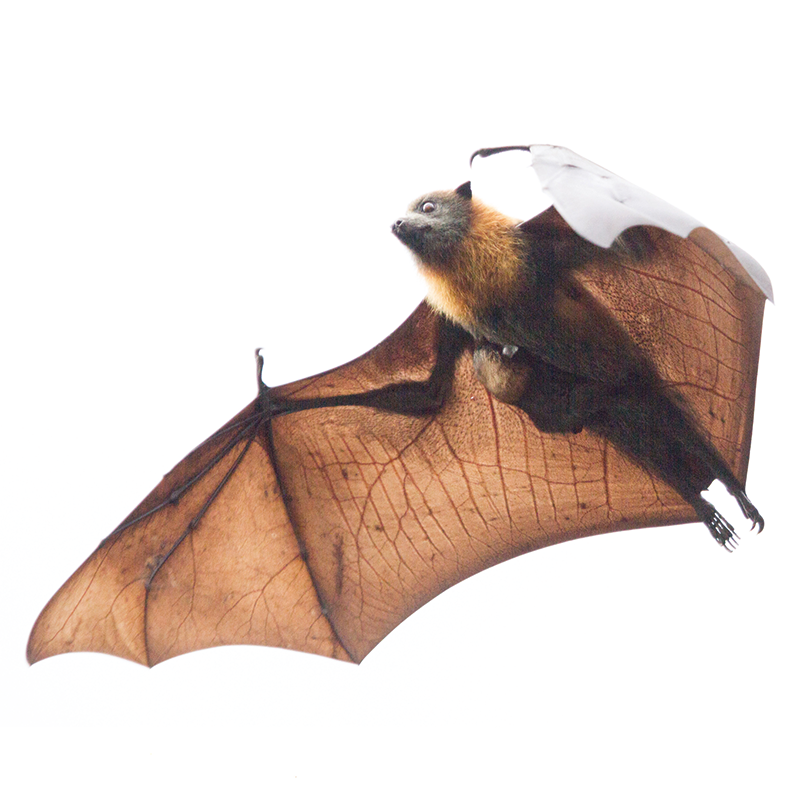
Myotis lucifugus
Color: Light to dark brown or gray-brown.
Shape: Small mammal with glossy fur.
Size: 3.5 inches with a wingspan of 10 inches, weighing ¼ oz.
The only mammal capable of real flight, bats use both their legs and wings to fly.
Bat Habits
Similar to human radar technology, bats use echolocation to fly and gather their food, which consists primarily of insects. With an average lifespan of 25-40 years, bats typically bear one pup per year, usually in the late spring or summer.
Forming maternal colonies inside buildings and caves, a single bat colony can range from 40 bats to 20,000 bats, so the damage done to structures can be extensive. When a cave becomes overpopulated, bat populations will turn to household attics that resemble caves when rearing their pups. Most active at dawn and dusk, bats leave their nests and feed on insects during the night, returning to their caves at sunrise.
While bats can enter homes through gaps as small at 3/8 of an inch, common entry points include broken windows and gaps near vents. Since it is illegal to poison or harm bats, it’s vital to secure your home against a bat invasion.
Do Bats Attack Humans?
Bats do not typically attack humans. These little mosquito hunters are equipped with an echolocation system that allows them to fly through the darkness at top speeds. While it may appear that they are swooping at your head, they are likely only hunting an insect above you.
However, while they may not attack humans, these creatures do pose some health risks and should be avoided. Although less than 0.05% of bats carry rabies, just like any other mammal, bats are capable of catching the disease. In addition to rabies, bats also carry histoplasmosis, a disease contracted by humans when dust from bat droppings is inhaled into the lungs.
Bat hair and bat guano can trigger allergies, and bats living in your attic can also carry fleas, ticks, and mites. Bat guano has also been known to corrode wood and drywall and become a source for mold growth.
Far from flying mice, bats aren’t actually rodents at all. Instead, they make up their very own group known as Chiroptera, which means hand-wing. And contrary to the phrase “blind as a bat,” most bats are not blind and can see just as well as humans.
Though many see bats as dirty and ugly, most of these little mammals have cute faces and soft, silky fur. Of the more than 1,100 species of bat, only 3 species are known to be vampiric, and none feed on humans. Most bat species feed on insects, fruit, nectar, and pollen. Pollinating our crops and protecting our health, bats eat billions of tons of insects every summer, and up to 1,000 mosquitos a night for one bat.
Signs of a Bat Infestation
Signs of a bat infestation include bat activity around your home at dawn and dusk, odors or sightings of bat guano, and hearing bats flapping or squeaking, especially if the colony is large.
Preventing a Bat Infestation
Performed during late fall, exclusion methods undertaken after bats have left structures in the winter can be quite effective. To prevent bats from taking over your attic, use Mylar flash tape to prevent roosting in carports and chimneys. Mothballs, screens, bright lights, and ultrasonic sound machines are also effective in deterring bats.
Removing Bats from Your Attic
Since bats feed on insects, poison is not likely to be a strong deterrent. In fact, in most states it is illegal to poison bats because of the valuable role they play in the ecosystem.
Once you are sure that all the bats have left for the winter, wear protective gloves and clothing, goggles, and a respiratory mask. Seal off any holes using boards, caulk, and screening materials. Use an enzyme cleaner to get rid of the smell.
If you live in a warmer area where bats do not migrate at wintertime, sealing up entry points will have to be done over a series of days to make sure no bats are sealed inside.
If you suspect an bat problem, contact Rochester Pest Pro for a quote.
